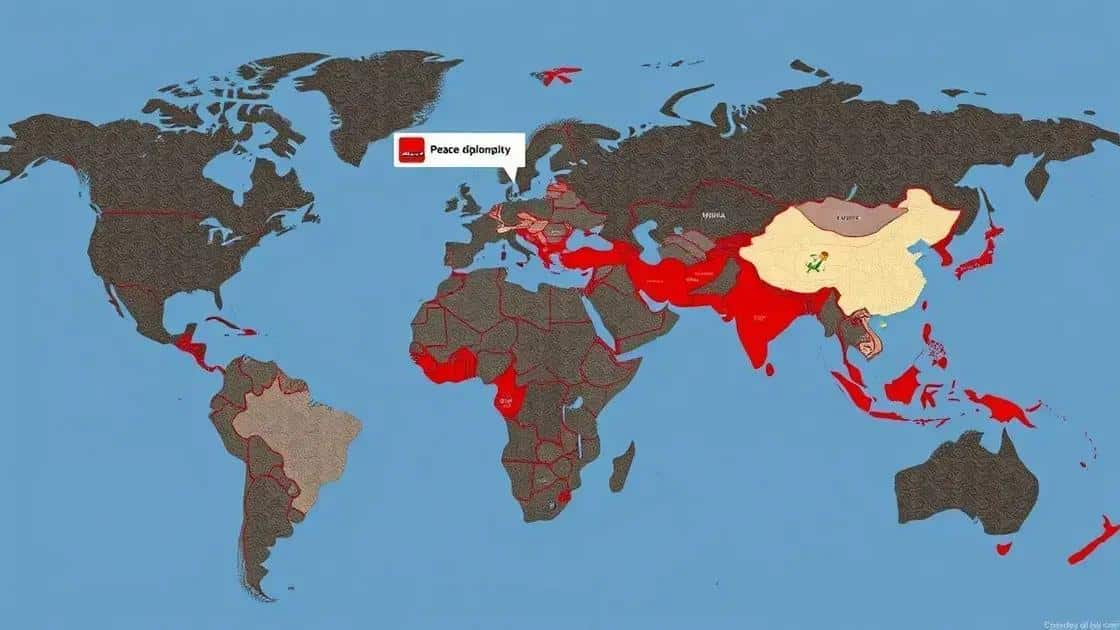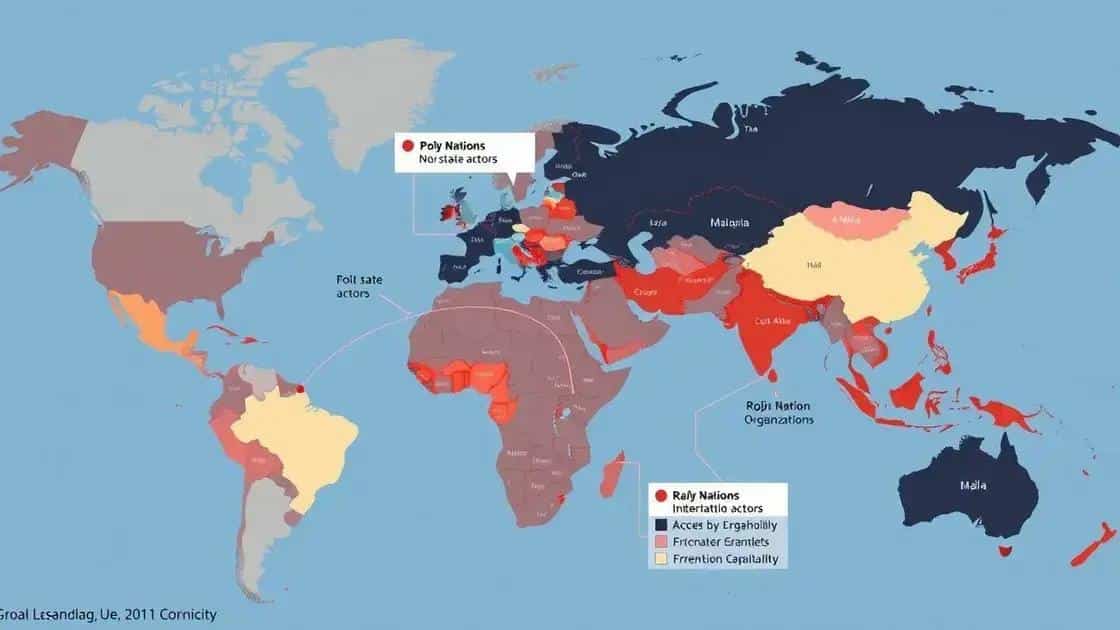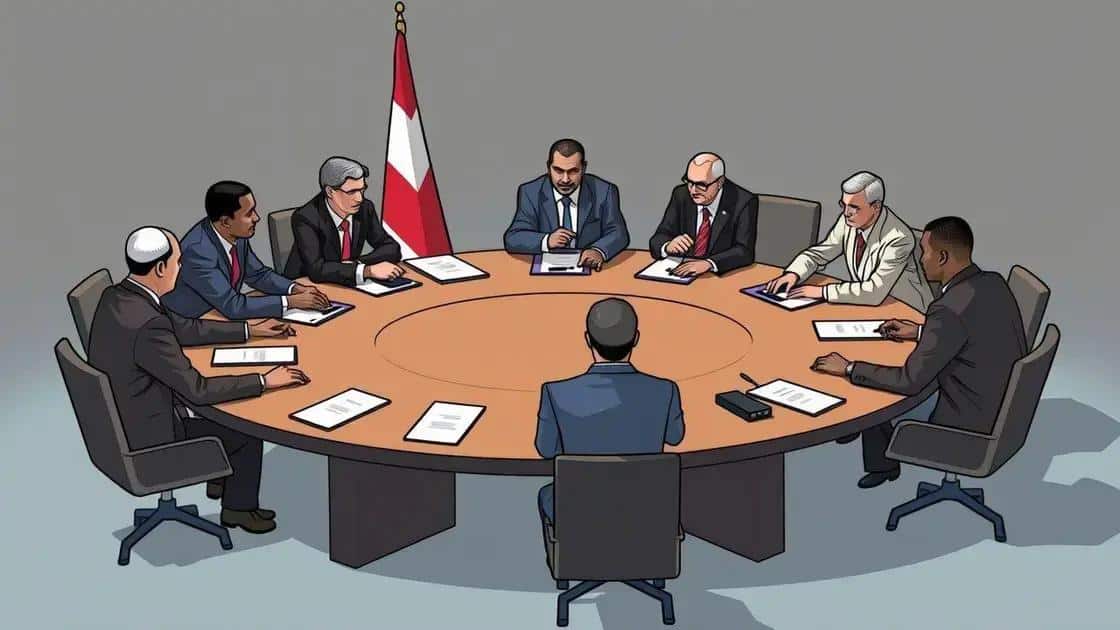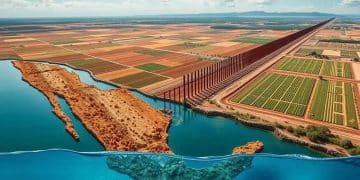International conflict: understanding its roots and implications

Anúncios
International conflict arises from historical grievances, territorial disputes, and cultural differences, necessitating diplomatic efforts and cooperation among nations for effective resolution and long-term peace.
International conflict is a pressing issue that affects nations and communities around the globe. Have you ever wondered how these conflicts begin and what keeps them alive? Let’s explore this complex topic together.
Anúncios
The historical context of international conflicts
Understanding the historical context of international conflicts provides essential insight into why they occur. Conflicts often stem from deep-seated issues that go back decades or even centuries.
Nations can have historical grievances, disputed territories, or cultural differences that lead to tensions. For instance, the roots of conflicts can often be traced back to colonialism, which created divisions and resentments that persist today.
Colonial Legacies
Many modern conflicts arise from the legacies of colonial rule. These include:
Anúncios
- Artificial borders established without regard for ethnic groups.
- Exploitation of local resources that enriched colonizers.
- Cultural suppression leading to identity conflicts.
These factors contribute to ongoing disputes among nations. Additionally, the impact of World War I and World War II reshaped political landscapes globally. Countries that were once allies can become adversaries due to shifting power dynamics.
Cold War Influences
The Cold War further complicated international relations. It created a framework where countries aligned with either the United States or the Soviet Union, leading to proxy wars in various regions. For example, conflicts in Korea and Vietnam showcased the ideological battles of the time.
As countries gained independence, many faced internal strife fueled by those earlier influences. Understanding these historical elements is crucial in addressing current international tensions. It sheds light on the behavior of nations and their leaders, reflecting their past experiences.
The impact of historical context on today’s conflicts cannot be understated. The echoes of past grievances continue to shape national policies, alliances, and even public sentiment. As new generations inherit these issues, the complexities of international conflicts remain evident.
Key players in international conflicts today

The key players in international conflicts today shape the landscape of global relations. Understanding who these players are can provide insight into the complexities of ongoing disputes.
Nation-states often take center stage in conflicts, with each country pursuing its own interests. For example, major powers like the United States, China, and Russia wield significant influence. Their military capabilities and economic strength sometimes dictate the course of international relations.
Non-State Actors
Beyond traditional governments, non-state actors play crucial roles. These include:
- Terrorist organizations that challenge state authority.
- Borderless NGOs advocating for humanitarian causes.
- Multinational corporations that can affect policies through economic power.
These entities complicate the picture, often acting independently or in opposition to state interests.
International Organizations
International organizations also contribute significantly. Groups like the United Nations facilitate dialogue and resolution. They aim to mediate disputes and promote peace, although their effectiveness sometimes faces challenges.
Understanding the motives behind these key players is imperative. Their historical backgrounds, regional aspirations, and cultural contexts all come into play. Diplomatic relations can shift as they respond to changing circumstances.
Additionally, alliances and coalitions, such as NATO or ASEAN, form strategic partnerships that influence conflict dynamics. These agreements can bolster military cooperation or economic ties, affecting how conflicts unfold. Navigating the interests of these various players is essential for any hope of resolving international disputes.
The socio-economic impact of international disputes
The socio-economic impact of international disputes is profound and far-reaching. Conflicts can disrupt normal life, affecting both countries and their citizens. Economically, war and disputes can lead to significant losses.
For instance, resources that could be used for development might be redirected to military spending. This shift can stifle growth and diminish job opportunities. Beyond simple economics, there are human costs. Displacement of people in conflict zones leads to humanitarian crises.
Economic Consequences
When international disputes arise, several economic effects become evident:
- Decreased foreign investment due to instability.
- Increased defense spending at the expense of social services.
- Destruction of infrastructure that hampers local economies.
The lack of resources can lead to poverty and unemployment, creating a cycle of hardship for citizens.
Social Ramifications
On the social front, conflicts can tear communities apart. Families may be separated, and the social fabric may unravel. This leads to increased crime rates and social unrest, as people struggle to cope with losses and instability.
Moreover, education is often disrupted during conflicts. Schools may close, and children may miss critical years of education. This lost potential affects future generations, making recovery longer and more challenging.
International disputes also result in lasting psychological effects. Trauma can affect mental health, particularly among children who witness violence or displacement. Addressing these issues requires not only immediate humanitarian aid but also long-term recovery strategies to heal communities and rebuild lives.
Potential resolutions for ongoing conflicts

Finding potential resolutions for ongoing conflicts is critical to establishing peace and stability. Many approaches exist, each with its strengths and challenges. Effective conflict resolution often requires cooperation among various parties.
Dialogue and negotiation play key roles in resolving disputes. Through open discussions, conflicting parties can express their concerns and find common ground. Often, third-party mediators help facilitate these conversations, adding a neutral perspective.
Diplomatic Strategies
Several diplomatic strategies can help end conflicts:
- Peace treaties that outline terms for resolution.
- Ceasefire agreements to halt violence temporarily.
- Confidence-building measures to foster trust among parties.
Each of these strategies aims to create an environment conducive to peace. Successful diplomacy can lead to long-term solutions that address the root causes of conflicts.
International Cooperation
International organizations, such as the United Nations, play a vital role in conflict resolution. They provide resources and platforms for dialogue. Furthermore, the involvement of multiple nations can lend weight to peace agreements. Countries can use their influence to encourage cooperation and compromise.
In addition to international bodies, grassroots movements also contribute. Local communities often have insights and solutions that higher authorities might overlook. Encouraging local participation can lead to more sustainable outcomes.
Ultimately, resolving conflicts requires a multifaceted approach. Engaging multiple stakeholders and employing various strategies increases the chances of achieving lasting peace. By prioritizing empathy and understanding, the path to resolution can become clearer.
In conclusion, addressing international conflicts requires a comprehensive understanding of their causes and implications. By recognizing key players and the socio-economic impacts, we can work towards effective resolutions. Emphasizing dialogue, diplomacy, and collaboration is essential. Every step, no matter how small, contributes to building lasting peace and stability. Ultimately, fostering empathy and mutual respect among nations is crucial to breaking the cycle of conflict.
FAQ – Frequently Asked Questions about International Conflicts
What are the main causes of international conflicts?
International conflicts often arise from territorial disputes, historical grievances, and cultural differences among nations.
How do international organizations help resolve conflicts?
International organizations like the United Nations facilitate dialogue, mediate disputes, and provide resources to countries involved in conflicts.
What role do non-state actors play in international conflicts?
Non-state actors, such as terrorist groups and multinational corporations, can influence conflicts by impacting political dynamics and local economies.
What are some potential resolutions for ongoing conflicts?
Potential resolutions include diplomatic negotiations, peace treaties, ceasefire agreements, and grassroots initiatives that involve local communities.






